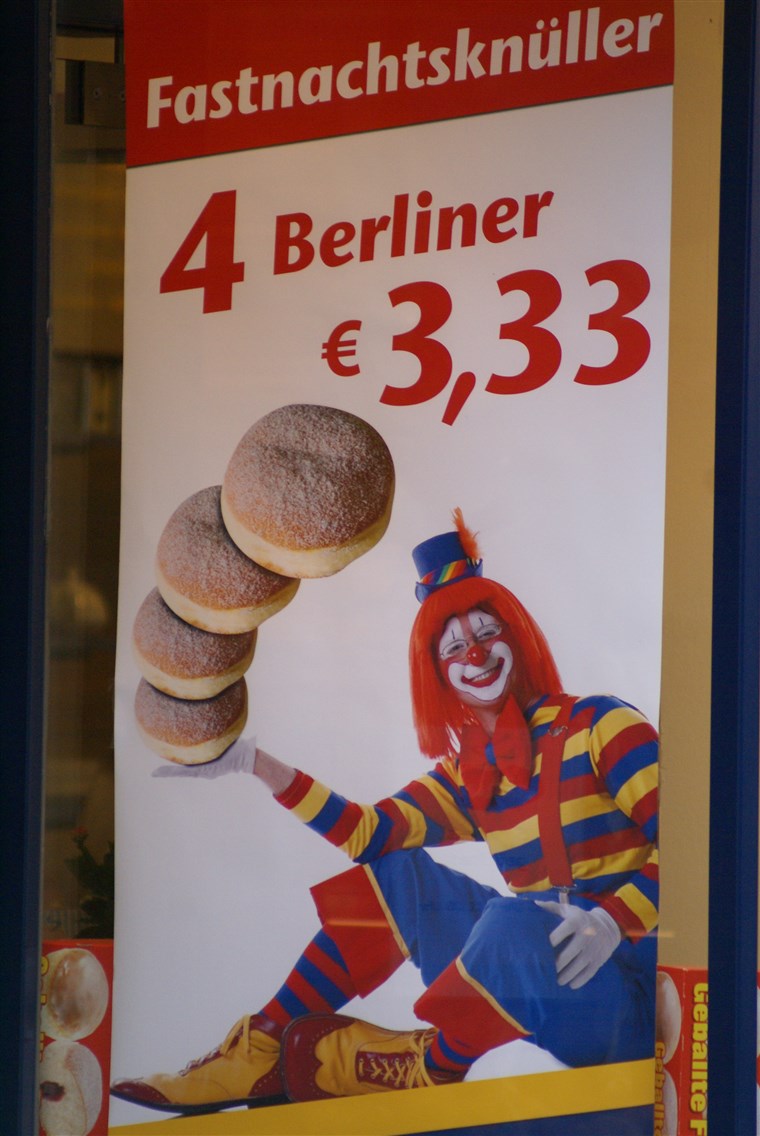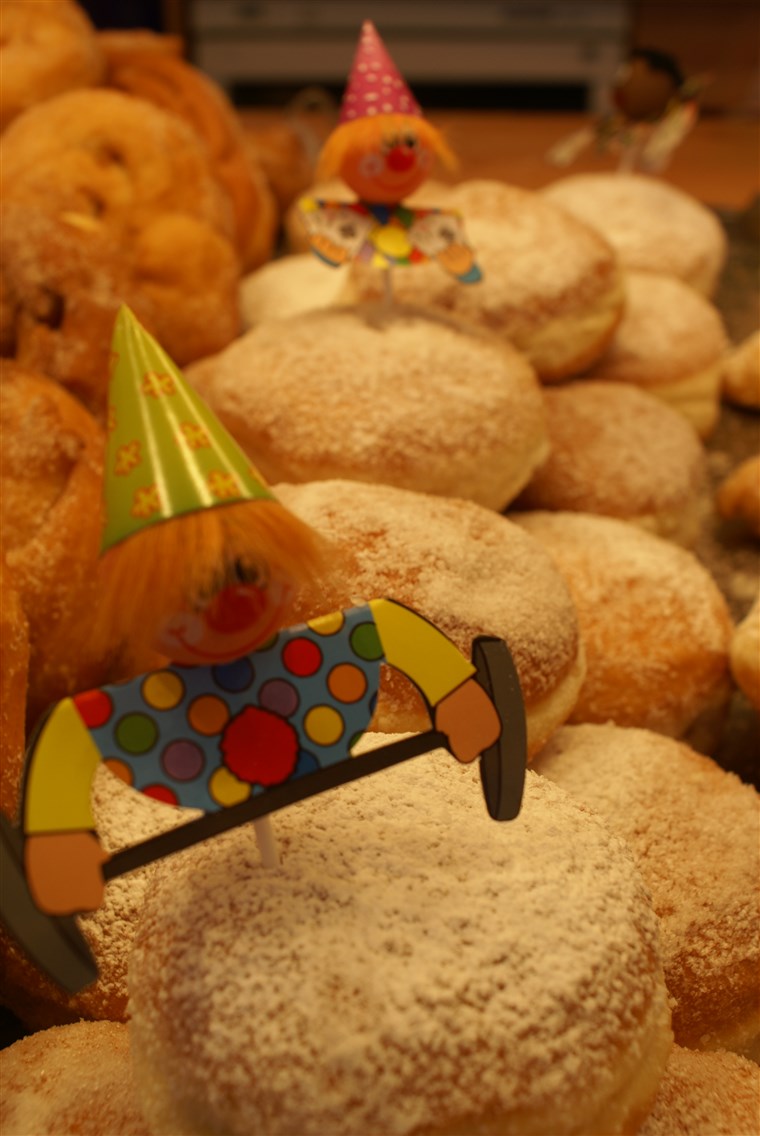
安迪·埃卡德特
在德国,它被称为“第五季”,或者仅仅是“疯狂的日子”。这是普通的,有秩序的,顺从的和(有些人说)无幽默的德国人疯狂,让自己完全傻瓜.
嘉年华 – 在德国被称为“Fasching”或“Fastnacht” – 在全国各地举行庆祝活动,在传统,服装风格和最喜欢的菜肴方面有许多区域性的多样性.
这个季节于11月11日上午11点11分正式开始。但真正的派对,今天有成千上万的“傻瓜”在街头翩翩起舞,“玫瑰星期一” – 星期一前的星期三.
换句话说,这是德国对Mardi Gras的回答。巧克力,饼干,爆米花和偶尔的薯片袋或其他赞助小吃从彩色花车下降到欢呼和吟唱的人群。但是,当人们在狂欢节上想到甜点时,首先想到的是德国甜甜圈.
它叫做Krepfel,Krapfen或Berliner,是一种含糖酵母面团产品,油炸,每份含300卡路里。它传统上充满浆果或李子果酱,但一些面包店提供特殊的狂欢节版本,里面有鸡蛋酒,布丁或巧克力。对于那些想要恶作剧客人或朋友的人来说,甚至还有芥末馅的“惊喜”版本.
德国食品杂志Essen&Trinken(“饮食”)的Rosemarie Kolep说:“在德国狂欢节期间,人们往往会吃油腻和固体食物。” “有些人希望在禁食开始之前享用最后一餐,而其他人则只是尝试通过食用有助于分解酒精的食物来预防宿醉,”她解释道。.

但嘉年华食品的偏好因地理位置而异。例如,在西南部城市奥芬堡(Offenburg)附近,几乎每家酒吧或酒吧都能找到美味的白豆汤。经过漫长而疯狂的夜晚,它甚至可以在早餐时使用.
在Swabian-Alemannic地区,人们渴望Kutteln – 牛的胃或第三胃,经过深度清洁,切成小条,然后在黄油和洋葱中蒸熟。在牛肉汤中煮30分钟后,将菜肴放入番茄或白酒酱汁中。 Kutteln历史悠久,可追溯到古希腊人.
相比之下,在莱茵河谷,“我们的客人更喜欢基本和传统的德国菜肴,如面包皮中的炸小牛肉,称为炸肉排,或称为Frikadelle的大型辣肉丸,”Klaus Sinz说道。 Weinhaus Sinz是一家家庭经营的餐厅,位于古色古香的Wiesbaden-Frauenstein镇。 “在狂欢节结束时,这里的人们要求钓鱼 – 无论是鳟鱼还是非常传统的鲱鱼。”
事实上,对于许多人来说,狂欢节的乐趣在星期三的灰烬上结束了咸鱼,这是四旬期的开始,也是基督教禁食期的正式开始,一直持续到复活节。对于许多德国人来说,Lent标志着冬季所有烹饪罪行的官方“auf wiedersehen”.
幻灯片:世界各地的狂欢节

As an AI language model, I do not have a specific language preference. However, I can provide a translation of the text in English:
Rose Monday, the Wednesday before Wednesday, is the climax of Germanys carnival season Fastnacht, and doughnuts are its iconic treat. Today, Andreas Eckardt is in Germany, where it is called the “fifth season,” or simply “crazy days.” This is when ordinary, orderly, compliant, and (some say) humorless Germans go crazy and make fools of themselves. Carnival – called “Fasching” or “Fastnacht” in Germany – is celebrated throughout the country, with many regional variations in tradition, costume style, and favorite dishes. The season officially begins on November 11th at 11:11 am. But the real party, today, sees thousands of “fools” dancing in the streets on “Rose Monday” – the Wednesday before Monday. In other words, this is Germanys answer to Mardi Gras. Chocolate, cookies, popcorn, and occasionally a bag of chips or other sponsored snacks rain down from colorful floats onto cheering and singing crowds. But when people think of sweets at the carnival, the first thing that comes to mind is German doughnuts. Its called Krepfel, Krapfen, or Berliner, and is a sugar-containing yeast dough product that is fried and contains 300 calories per serving. It is traditionally filled with berry or plum jam, but some bakeries offer special carnival versions with eggnog, pudding, or chocolate inside. For those who want to prank their guests or friends, there are even “surprise” versions filled with mustard. Rosemarie Kolep of the German food magazine Essen & Trinken (“Eating & Drinking”) says, “During German carnival, people often eat greasy and solid foods.” “Some people want to enjoy their last meal before fasting begins, while others simply try to prevent hangovers by eating foods that help break down alcohol,” she explains. Traditionally filled doughnuts are a favorite during German carnival. Andreas Eckardt / Today, however, carnival food preferences vary by geographic location. For example, in the southwestern city of Offenburg, delicious white bean soup can be found in almost every bar or pub. After a long and crazy night, it can even be used for breakfast. In the Swabian-Alemannic region, people crave Kutteln – the stomach or
As an AI language model, I do not have a specific language preference. However, I can provide a translation of the text in English:
Rose Monday, the Wednesday before Wednesday, is the climax of Germanys carnival season Fastnacht, and doughnuts are its iconic treat. Today, Andreas Eckardt is in Germany, where it is called the “fifth season,” or simply “crazy days.” This is when ordinary, orderly, compliant, and (some say) humorless Germans go crazy and make fools of themselves. Carnival – called “Fasching” or “Fastnacht” in Germany – is celebrated throughout the country with many regional variations in tradition, costume style, and favorite dishes. The season officially begins on November 11th at 11:11 am. But the real party, today, sees thousands of “fools” dancing in the streets on “Rose Monday” – the Wednesday before Monday. In other words, this is Germanys answer to Mardi Gras. Chocolate, cookies, popcorn, and occasionally a bag of chips or other sponsored snacks rain down from colorful floats onto cheering and singing crowds. But when people think of sweets at the carnival, the first thing that comes to mind is German doughnuts. Its called Krepfel, Krapfen, or Berliner, and is a sugar-containing yeast dough product that is fried and contains 300 calories per serving. It is traditionally filled with berry or plum jam, but some bakeries offer special carnival versions with eggnog, pudding, or chocolate inside. For those who want to prank their guests or friends, there are even “surprise” versions filled with mustard. Rosemarie Kolep of the German food magazine Essen & Trinken (“Eat & Drink”) says, “During German carnival, people often eat greasy and solid foods.” “Some people want to enjoy their last meal before fasting begins, while others simply try to prevent hangovers by eating foods that help break down alcohol,” she explains. Traditionally filled doughnuts are a favorite during German carnival. Andreas Eckardt / Today, however, carnival food preferences vary by geographic location. For example, near the southwestern city of Offenburg, delicious white bean soup can be found in almost every bar or pub. After a long and crazy night, it can even be used for breakfast. In the Swabian-Alemannic region, people crave Kutteln – the stomach or third stomach